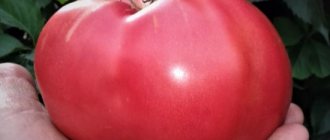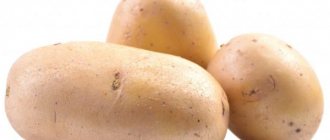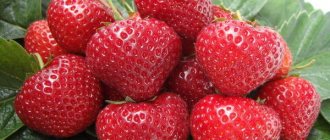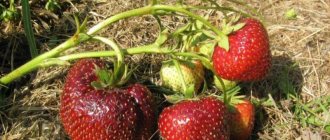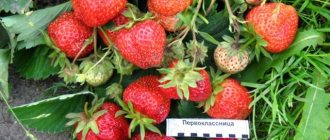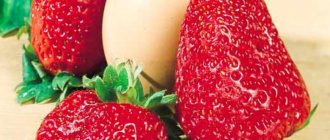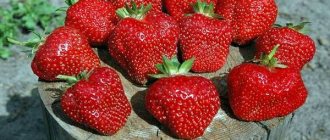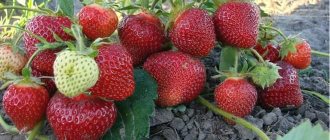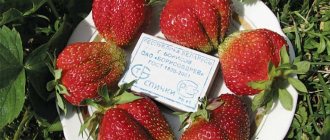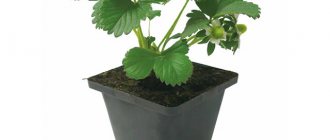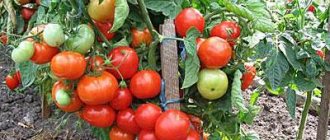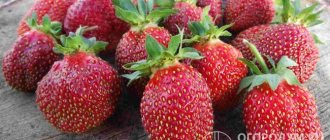Euphoria after the arrival of the next king of the market berries gives way to thoughtfulness. And often - by searching for new, more successful new products. Take a closer look at this one - everyone’s experience of growing Portola is different, perhaps it will interest you.
Euphoria after the arrival of the next king of the market berries gives way to thoughtfulness. And often - by searching for new, more successful new products. Take a closer look at this one - everyone’s experience of growing Portola is different, perhaps it will interest you.
In the photo of Portola in the first year of planting - it is better to remove the flower stalks, they are still weak and small
A day-neutral variety developed at the University of California Univ. of California. New to the strawberry market. Improved form of Albion - developed as a result of selection of seedlings Cal 97.93-7 x Cal 97.209-1. The better - according to large farms, the yield is 30% higher than Albion, which has become synonymous with the industrial strawberry variety. By the way, it is similar in appearance to this variety - a little lighter, the flesh is more tender - and this is only beneficial. According to various sources, from the originator to those who grow the variety, from 250-300 g per bush with average care, to 900 -1.7 kg with industrial cultivation.
Main characteristics
Portola strawberry is a remontant crop. It is distinguished by long-term fruiting, unlike other bushes. Strawberries of the Portola variety bear fruit from the beginning of May to the end of July. Gardeners around the world collect most of the fruits in the autumn.
Fruit buds on Portola bushes form every 6 weeks. This process is not affected by daylight hours or temperature. It is for this reason that Portola strawberry bushes can be harvested before the first frost. Strawberry bushes of this variety have continuous fruiting. So, on one plant there can be new flowers and already ripe fruits.
From one strawberry bush, gardeners can get a rich harvest, but for this they need to work hard. Since the Portola strawberry wants to receive maximum attention and care. Bushes require fertile soil, careful nutrition, abundant watering and plenty of space to grow.
The average weight of one fruit of the Portola variety reaches 35 g. This is a very aromatic and juicy berry. The pulp is quite dense, so the fruits tolerate transportation well without losing their presentation. If you store Portola strawberries at a temperature range of 0 to 3 degrees, they will not lose their attractive appearance and taste.
From one bush you can harvest from 1 to 2 kg of crop. It all depends on proper care and compliance with all rules of agricultural technology.
An excellent variety of garden remontant strawberries! Portola, meet me.
Portola strawberries are the fruit of breeding work by Californian scientists, bred in 2009 as a descendant of the well-known Albion. This variety is suitable for cultivation both in open and closed ground. In flowerpots and balcony boxes, in greenhouses and in the open air, Portola is invariably successful and chic like no other variety. The height of the plant is about 20-25 cm. The bush is quite spreading, so it requires sparse planting. The variety is demanding in terms of growing conditions - it does not tolerate drying out or overwatering of the soil. Everything should be in moderation.
Young Portola strawberry plant
The berries are large and have the shape of a wide cone. The color is juicy red, close to crimson, with shine. The density of the berry allows it to retain its presentation for a long time and also be transported without problems. The berry is crunchy and easy to cut into a salad or to decorate a cake. I’m more than sure that such fruits will not get soft when making jam.
Strawberry remontant Portola
The taste is wonderful, but Portola strawberries tend to shrink and lose this wonderfulness towards the end of the season. But, thanks to the decorative nature of the bush and the attractive appearance of the berries, it is a very decorative decoration for a garden or loggia.
Strawberry Portola berry 32 grams
It produces mustache in sufficient quantities, but not as much as Aromas. Our Portola strawberries grow on a hillock between young apple trees. The place is open and sunny, so the soil dries out quickly. To avoid this, a large amount of vermicompost is added to the holes, and a layer of rotted straw with goat manure is added to the surface of the soil under the plant, at the end of the season. Perforated cups with a mixture of earth and vermicompost are installed under Portola's mustache. After placing the mustaches in them, they are additionally mulched with rotted straw and manure. Watering is not too abundant, as needed. In case of persistent hot weather, once every three days. Subsequently, all that remains is to cut off the mustache and transplant the seedling to a permanent place.
Portola reproduction by mustache
Portola is prone to fungal and viral diseases (chlorosis, spotting, etc.), so it has some difficulties in care. I don’t recommend it to beginners to avoid disappointment. For more experienced gardeners with a built-in system of fertilizing and disease prevention, my resounding “Yes.”
garden strawberries, remontant large-fruited soil, garden strawberry varieties, photo strawberries
Flaws
Portola strawberries, like any other crop, have their advantages and disadvantages. The advantages were mentioned earlier, but the disadvantages include:
- The amount of sugar contained in a berry directly depends on the weather conditions in which the crop grows. So, in cloudy weather, the fruits will not be very sweet.
- If the rules of agricultural technology are not followed and fertilizing is insufficient, the berries significantly lose size, become small and unattractive.
- If it is very hot in the area where strawberries grow, this will greatly affect the taste of the berry, as well as its juiciness.
- If the air temperature is very high at the time of planting, the seedlings will take root poorly.
- Strawberries of the Portola variety are susceptible to such unpleasant diseases and pests as: some viral and fungal infections, chlorosis and some spotting.
STRAWBERRY VARIETY “PORTOLA”.
One of the relatively new remontant varieties was bred in the USA in 2009. The bush is tall, leafy, and quite compact. The leaf is dark green and shiny. The adaptation is average. The berry is wide-cone-shaped, very large, weighty, bright red in color with shine. Excellent harmonious taste is the main advantage of the variety. The berries are of excellent quality, dense in consistency, but not hard, which allows the harvest to remain marketable for quite a long time. “Portola” is suitable for both outdoor cultivation and greenhouses. Winter hardiness is high, resistance to diseases and pests is at the level of world standards.
Buy strawberry seedlings “PORTOLA”.
We guarantee the quality of Portola strawberry seedlings and are responsible for their safety in transit. Thanks to professional packaging and a closed root system, Portola strawberry seedlings reach any region of the country in excellent condition.
Order Portola strawberries: in the online store, by phone. 8 982 25 75 224, by mail
| Our company is a FEDERAL CORPORATE CLIENT of Russian Post; under an agreement with Russian Post, our parcels are delivered only to the Main Post Office (and not to regional post offices!), which reduces delivery times, and are sent out of turn! We take into account the nuances of the postal service and know when it is better to hand over parcels so that they leave our city on the same day (or at least the next day) and go to customers. |
The average cost of shipping by Russian Post is 300-350 rubles, shipping by EMS airmail is on average 1500-1800 rubles.
Answers to frequently asked questions:
2. We do not cut shrub seedlings to fit the box and do not remove strawberry leaves (the plants tolerate shipping with leaves well!; sometimes, during a particularly long shipment, the leaves may become slightly discolored - this is quite normal!)
3. If possible, we try to take into account your wishes about delivery times, so that you have the opportunity to choose a suitable time for landing (the weather has been favorable in the region, a place has been prepared for landing, etc.)
4. We do not purchase plants or hire hired workers: we grow, assemble and pack the plants ourselves - very meticulously, carefully and scrupulously - we work for quality, not speed! Sometimes this means you may have to wait a bit for your order - be patient!
5. Thanks to professional packaging, strawberries in parcels never get wrinkled and seedlings never break!
6 . All plants were grown in the Urals (northern Perm region) in open ground in a risky farming zone and adapted to difficult climatic conditions. For example:
– end of October 2021: no snow, temperature -16-18 degrees C; – January 2021: during the week it costs -45 UAH; – June 1, 2021: it’s snowing, etc.
The Ural weather constantly presents us with such surprises, but the species and varieties of plants we have selected live, grow, bloom luxuriantly and bear fruit magnificently no matter what!
7. Working with LIVE plants in considerable volumes, sending them to the most remote regions of the country and even abroad, we extremely rarely receive quality complaints (there were only 4 of them in 2021!), so if for some reason the plants damaged during shipment, we can afford to resend the plants to the customer free of charge!
8. In the off-season, you can consult with manufacturers. We will tell you how to choose the right crops and varieties, prepare the soil, plant plants, feed, shape, propagate, spending a minimum of effort, getting maximum returns. We have a wealth of experience and we are ready to share it! Contact us! NOTE! In the spring-summer period, during the work and mailing season, due to workload, we are not able to provide advice or answer all calls and messages! Hope for understanding!
9. Family works! Manual labor without outside help requires considerable time and physical effort, eliminates re-grading and confusion, and guarantees high quality planting material. This is where the price of our products comes from.
10. Our collection of plants, collected since 1988, contains new items from domestic and foreign selection, unique rarities and selected varieties of favorite classics. Do you want to get consistently high yields of berries on your plot and decorate your garden with stunningly beautiful ornamental plants? We invite you to cooperate! The choice is huge - choose!
Sincerely, Agrofirm “Victoria” (Perm).
Strawberries (strawberries) “PORTOLA”, reviews.
We discuss the taste of the Portola variety, yield, winter hardiness, disease resistance and other qualities. Characteristics of the variety, advantages and disadvantages. Growing Portola strawberries in the northern and southern regions in open ground and in greenhouses, fruiting dates. Feedback from gardeners about the Portola strawberry variety from different regions of the country: we answer questions, share impressions, boast about the harvest, and exchange photos.
Landing
For Portola strawberries, loamy soils with weak acidity or neutral are more suitable. If the soil in the beds intended for planting strawberries is peaty or soddy-podzolic, then the area will need to be prepared. To do this, you need to change the place, or get land suitable for the culture.
Young plants can be bought at any nursery that specializes in strawberry seedlings. You can also propagate strawberries yourself. This can be done by dividing the bush or using tendrils. As for the time of planting, the event is carried out either at the beginning of spring or at the end of summer. So there is a high probability that the plants will take root, take root well, and next year they will begin to produce a bountiful harvest of juicy and aromatic berries.
Soil preparation
The bed for planting seedlings must be prepared in advance. If planting is planned in the spring, then the soil is cultivated in the fall. If you want to plant planting material in the fall, then the soil is prepared in the spring.
Soil preparation occurs as follows:
- First, the ground is thoroughly dug up using a fork, and all weeds and roots of plants previously growing on the site are removed.
- After this, organic fertilizers are added to the soil - 1 bucket per 1 sq.m. and wood ash - 5 kg per 1 sq.m.
- 1 month before planting, 20 g of potassium sulfate and 40 g of superphosphate are added to the soil. Both one and the other substance can be replaced with “Kaliphos”. It is enough to add just 1 tbsp. per 1 sq.m.
Planting scheme
When planting Portola strawberries, you must adhere to a certain pattern: 40cm between bushes and 80cm between rows. This culture requires a lot of space.
Bushes are placed in the ground only in cloudy weather. Initially, the holes are watered abundantly with water, after which the seedling is sent into it and the roots are carefully placed over the entire surface. After the seedling is covered with soil, pay special attention to ensure that the heart is above the soil level.
To ensure that there are no voids between the roots of the plant, the soil at the base of the root is slightly pressed, after which the bushes are watered and immediately mulched. Before winter, it is necessary to pick off all the flowers that appear on the plants. This should be done so that next year the strawberries will produce a good harvest.
Care
The basic rules for caring for Portola strawberries are not much different from caring for any other variety. But based on its description and reviews from experienced gardeners, it is worth noting that Portola requires a lot of attention. If some points are ignored, then as a result you will get a not very high-quality harvest of small berries that will lose their sweetness. It is important to know that Portola does not tolerate sudden changes in temperature. From the very beginning of the season, gardeners must correctly observe:
- Watering. If Portola is grown for industrial purposes, then it cannot be done without drip irrigation. Provide the crop with strip watering.
- Feeding. With the arrival of spring, the strawberry bushes of the variety are carefully cleared of old foliage, after which fertilizing is applied in the form of ammonium nitrate. By the end of May, fertilizing containing nitrogen is applied to the soil.
As soon as the first buds begin to appear on the bushes, it would be good to add “Growth Concentrate” to the ground. During the setting of the first fruits, plants need potassium nutrition.
Capricious Portola, relative of all the best neutrals
Euphoria after the arrival of the next king of the market berries gives way to thoughtfulness. And often - by searching for new, more successful new products. Take a closer look at it: the successor to one of the best industrial neutrals, which everyone knows, its “improved version” - the Portola strawberry can please and sadden, everyone’s growing experience is different.
Read also: HOM - a plant protection product
Strawberry Portola is a day-neutral variety developed at the University of California Univ. of California.
It is called the “improved form” of Albion - obtained as a result of selection of seedlings Cal 97.93-7 x Cal 97.209-1, recognized as a variety in 2009.
The better the predecessor - according to large farms, the yield is 30% higher than Albion, which has become synonymous with the industrial strawberry variety.
By the way, it is similar in appearance to this variety - a little lighter, the flesh is more tender - and this is beneficial.
The yield of Portola strawberries, according to various sources, from the originator to those who grow the variety, is from 250-300 g per bush with average care, to 900-1.7 kg for industrial cultivation.
Fruits in waves from June to October, until frost. At the beginning of the season, the berries are larger, towards the end they become smaller, less sweet, but retain a luxurious appearance.
Diseases
Strawberry varieties have a high level of resistance to diseases such as powdery mildew, rot, wilt, and powder mold. But the same cannot be said about rotting fruits, various kinds of spots and leaf burns. In such cases, special measures must be taken. For example, in order to avoid a fungal disease, with the arrival of spring, the areas where strawberry bushes grow must be treated with Fitosporin. Treatment of plants is carried out with copper oxychloride.
The procedure is performed during the growth of new leaves. Repeated activities are carried out before the bushes begin to flower and after the fruits are harvested. The drug is easily replaced with Bordeaux mixture. It is very important to maintain cleanliness in the beds where Portola grows. The bushes should not grow too much and be overgrown with grass.
Strawberry Portola: variety description, photos, reviews
Club Regular
Messages: 3540 Registration: 4.1.2012 From: Minsk +375-29-319-27-28, +375-29-761-15-14
Dacha in Maryina Gorka, Minsk region.
Well, now not from the site, but from my garden. I, as always, am with my spoon of milk. Sorry, it is what it is.
I planted it, brought from Batkiv Garden, with frigo seedlings in the spring of 2012. Everything took off right away and at first it grew well. And then it began. At the beginning of June the bushes began to hurt very badly. It was processed at the same level as other varieties, but only Partola was covered in spots. But I fought as hard as I could, and at the end of July I planted 30 young mustaches.
Protecting plants from fruit rotting
This is one of the most unpleasant diseases that Portola strawberries carry. Treatment methods for this disease depend on its origin. For example, white rot is treated by simply spraying plants with chemicals. Most often they use Derosal or analogues. If the plant is overtaken by gray rot, then in this case the ridges are initially sprayed with Bordeaux mixture, and then with chemicals.
To prevent white rot, it is necessary to get rid of already infected plants in a timely manner, monitor good air flow in the ridges and at the time of planting, be as careful as possible and place only high-quality, healthy plants in the soil.
In order to avoid the occurrence of gray rot, it is enough to ensure that the seedlings are not planted close to each other, change the planting location every 2-3 years and cover all plants with film during heavy rains.
Reproduction by antennae
Although this propagation method is not the most promising for Portola strawberries, if you follow all the rules and subtleties, you can get good planting material.
Despite the fact that a small number of tendrils are formed on the strawberry bushes of the Portola variety, it reproduces well with their help. During the fruiting period, gardeners note the strongest bushes with a high level of productivity.
With the arrival of spring, the flower stalks on such bushes specially break off. In order to propagate Portola strawberries, the two most powerful rosettes are left, which are closest to the mother bush. Plastic cups are placed under these sockets, into which nutritious soil is obviously added. Already at the end of summer, young, well-rooted plants are planted in open ground or greenhouses.
Characteristics of the variety, its advantages and disadvantages
The plant itself is a powerful bush with large light green leaves. The berries are red-orange with pink flesh and good taste. They reach a weight of 20 g, are characterized by resistance to deformation and good transportability, and are suitable for various shapes of workpieces. However, if the bushes are not properly cared for, then over time the berries become smaller.
This variety is mid-season, intended for cultivation in open ground. Although it is noted that it is also suitable for greenhouses, the harvest will not be early. Figaro loves sunny places with light to medium soils. Resistant to mild frosts.
Gardeners should not be afraid of a low yield in the first year of fruiting - Figaro will show its maximum in the 2nd year. It is noted that the variety produces slightly less than 1 kg of berries from one bush. Figaro is often compared to the Elsanta variety. The results are ambiguous: Figaro has almost half the berries, but Elsanta has higher yield stability.
The advantages of Figaro include:
- fruit size, their aesthetic and taste qualities;
- frost resistance;
- good keeping quality and transportability;
The disadvantages include:
- unstable yield;
- the exactingness and capriciousness of strawberries in compliance with agricultural technology;
- low vegetation potential.
Advice from experienced gardeners
People who have been breeding and growing strawberries for several years claim that:
- Peduncles of the first row must be removed. This is necessary so that the peduncles of the second row become more powerful.
- It is possible to obtain the desired yield and a high level of crop development only if intensive agricultural technology has been carried out and the conditions for growing Portola have been favorable.
- To harvest throughout the entire fruiting period, plant Portola bushes along with other mid-season varieties.
- Most often, Portola strawberries are propagated in three ways: by tendrils, by dividing the bush, and by seeds. Although propagating Portola using seeds is a more labor-intensive process that requires great attention and a lot of time, gardeners all over the world use this method most often. This happens for the simple reason that the plant does not produce very many mustaches.
- It is imperative to mulch the beds with Portola strawberries. Since this variety has high watering requirements, the mulch will retain moisture longer and will prevent the soil from drying out.
In areas where a cool climate predominates, strawberry varieties will feel comfortable in protected ground. The first harvest occurs very early, which has a beneficial effect on the further preparation of the plant for winter. With the arrival of autumn, the beds of the Portola variety must be covered with straw or dry leaves. This will help protect the plants from freezing.
Reviews
The description of the strawberry variety “Portola”, supplemented by reviews and photos of the plant, gives a complete picture of the acquaintance.
Elena, Belgorod
I love this variety of strawberry. I like “Portola” for its ideal berry shape. Any plant needs to be looked after. Therefore, if a gardener chooses only unpretentious varieties, he will not be able to appreciate some of the highlights of the crop. I grow the variety in a greenhouse and it bears fruit in winter. The only caveat is that I often change bushes. I don’t keep it for more than 3 years, otherwise the berries become small and the harvest is weak.
Victor, Krasnodar
Berry of controversial taste. Some of my friends prefer to choose a different variety. I am satisfied with Portola for its productivity and ability to transport. For a farmer this is an ideal characteristic. The berries do not wrinkle, the presentation is excellent, and sales are always excellent. Previously, I grew it without drip irrigation, it was worse. Now we carried out strip irrigation, and the yield immediately increased.
